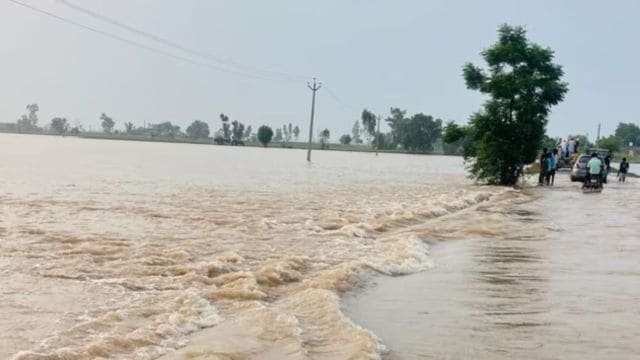More rains in Punjab, but water level drops in Beas and Sutlej
Use of boats and makeshift carriers to reach milk collection points in flooded villages, have so far ensured uninterrupted procurement of raw milk
 The Punjab Chief Electoral Officer, Sibin C stated that Punjab had suffered the worst floods in its history with all 23 districts under effect. (File Photo)
The Punjab Chief Electoral Officer, Sibin C stated that Punjab had suffered the worst floods in its history with all 23 districts under effect. (File Photo)Parts of Punjab, lready battling devastating floods, were lashed by rain Saturday, with Ludhiana, which has since the flooding witnessed four deaths, receiving the highest amount of it.
According to the Met department, Ludhiana received 81.2 mm of precipitation while Amritsar received 38.4 mm and Patiala 25 mm.
Meanwhile, the water level in the Pong dam marginally dipped to 1,394.19 feet, though it remained four feet above its upper limit of 1,390 feet, officials said. The water level in the dam was 1,394.8 feet on Friday evening. The water inflow also declined to 47,162 cusecs from 99,673 cusecs on Friday, while the outflow remained unchanged at 99,673 cusecs, according to the officials.
In case of the Bhakra dam, the water level was 1,678.14 feet as against 1,678.47 feet on Friday. The water inflow in the dam, built on the Sutlej river, stood at 62,481 cusecs and the outflow was 52,000 cusecs, the officials said.
Tarn Taran Deputy Commissioner Rahul Sindhu said the falling water levels in the Beas and Sutlej have brought relief to residents living along the riverbanks in the district. He said the water level at Harike Headworks has also decreased, leading to reduced downstream release and a decline in the flow of the Sutlej in the Harike Hathar area. “The reduced flow in the rivers gives us more time to strengthen weak spots along the rivers and vulnerable points on the Dhussi bundh,” he said.
The DC said that despite the drop in water levels, the district administration is maintaining round-the-clock monitoring of the Dhussi bundh in coordination with villagers, social organisations, and religious institutions to detect and repair any leakage points.
He thanked villagers, social and religious organisations, and the Army for their support in dealing with the flood situation. “Without their cooperation, facing such conditions would be very difficult,” he said.
Sindhu added that near village Marar, close to Harike town, the river had eroded a section of the bundh, which is now being reinforced with the joint effort of the administration, villagers, religious bodies, and the Army.
Punjab Milkfed seeks Rs 50 cr grant from NDDB to provide free cattle feed
Punjab Milkfed Saturday sought a grant of Rs 50 crore from the National Dairy Development Board (NDDB) for distribution of cattle feed in flood-affected districts, officials said. The state cooperative has activated a two-fold strategy – sustaining dairy farmers and livestock, while simultaneously ensuring supply of milk and food essentials to the affected population, they said.
Financial Commissioner (Cooperation) Sumer Gurjar said, “This is not just relief, it is a reaffirmation of bond with Punjab’s people. Our teams are on the ground to protect farmers’ livelihoods, safeguard animals, and ensure that no family is left without nourishment.” With transportation routes submerged, dairy farmers have been unable to move milk, sinking into a severe financial distress, Gurjar said in a statement.
Use of boats and makeshift carriers to reach milk collection points in flooded villages, have so far ensured uninterrupted procurement of raw milk, he said.
Milkfed managing director Rahul Gupta said thousands of cattle heads stranded in submerged sheds are on top priority for support. Milkfed, in coordination with affiliated milk unions, is supplying cattle feed and ‘chokar’ (bran) at subsidised rates.
To scale, the Milkfed has approached the NDDB for a Rs 50 crore grant, which, once approved, will enable free distribution of cattle feed across affected districts. The Milkfed is working through district administrations to supply fresh milk, skimmed milk powder, whole milk powder, and dairy whitener. These commodities are particularly critical for families with children, elderly, and vulnerable populations.
The Milkfed and its unions have pledged 15,000 food kits for flood-affected families.
Punjab is facing one of its worst floods in decades, with the Sutlej, Beas, Ravi and several seasonal rivulets in spate due to heavy rain across north India, especially Punjab, Jammu and Kashmir, and Himachal Pradesh.
With PTI







